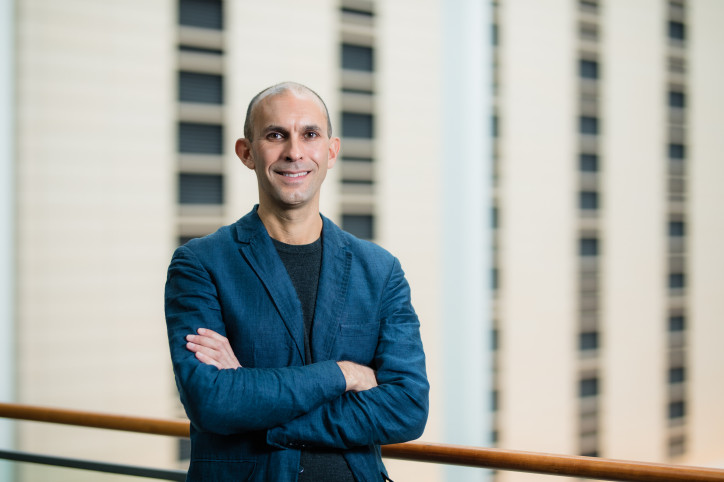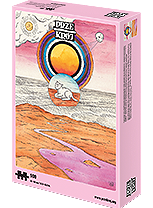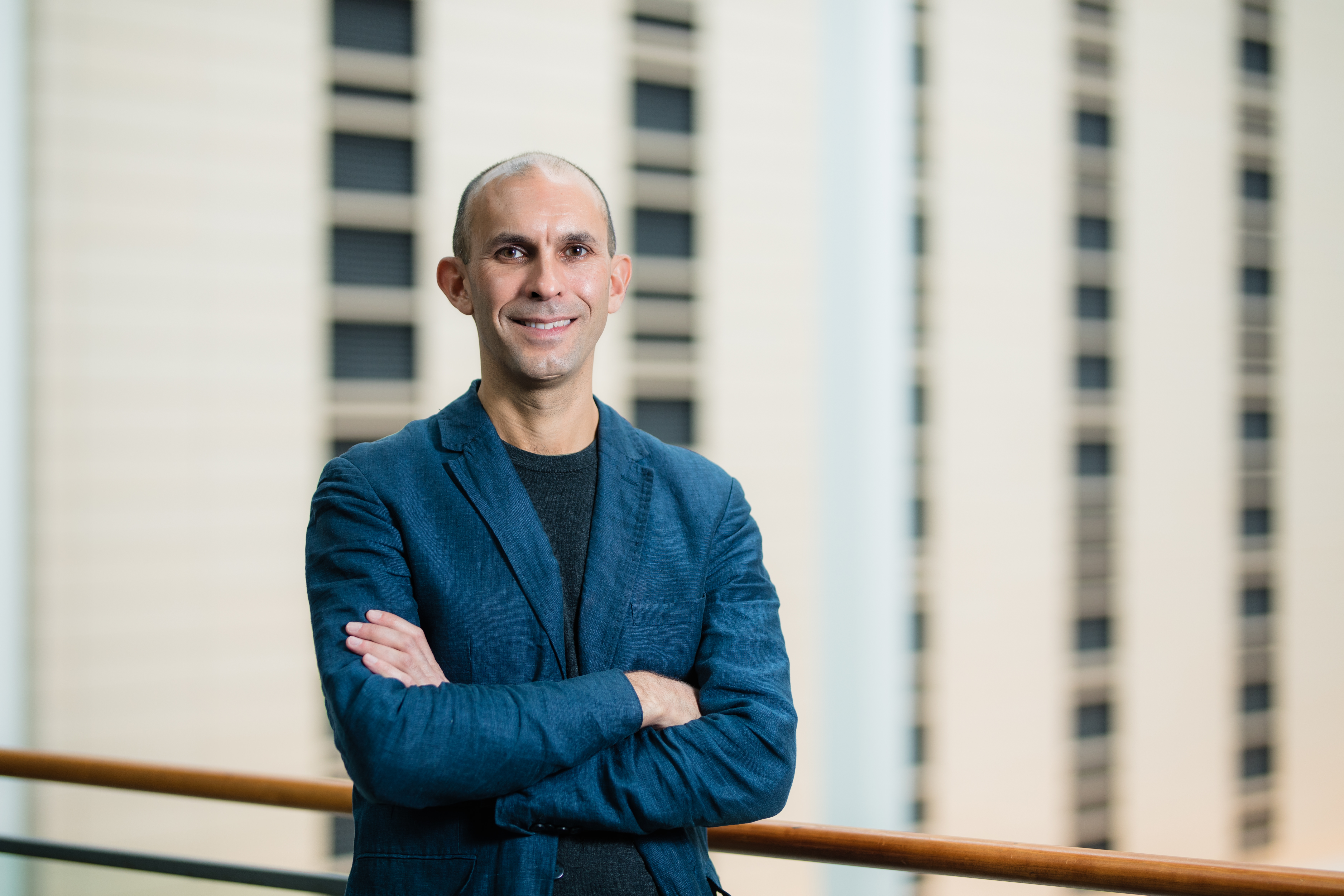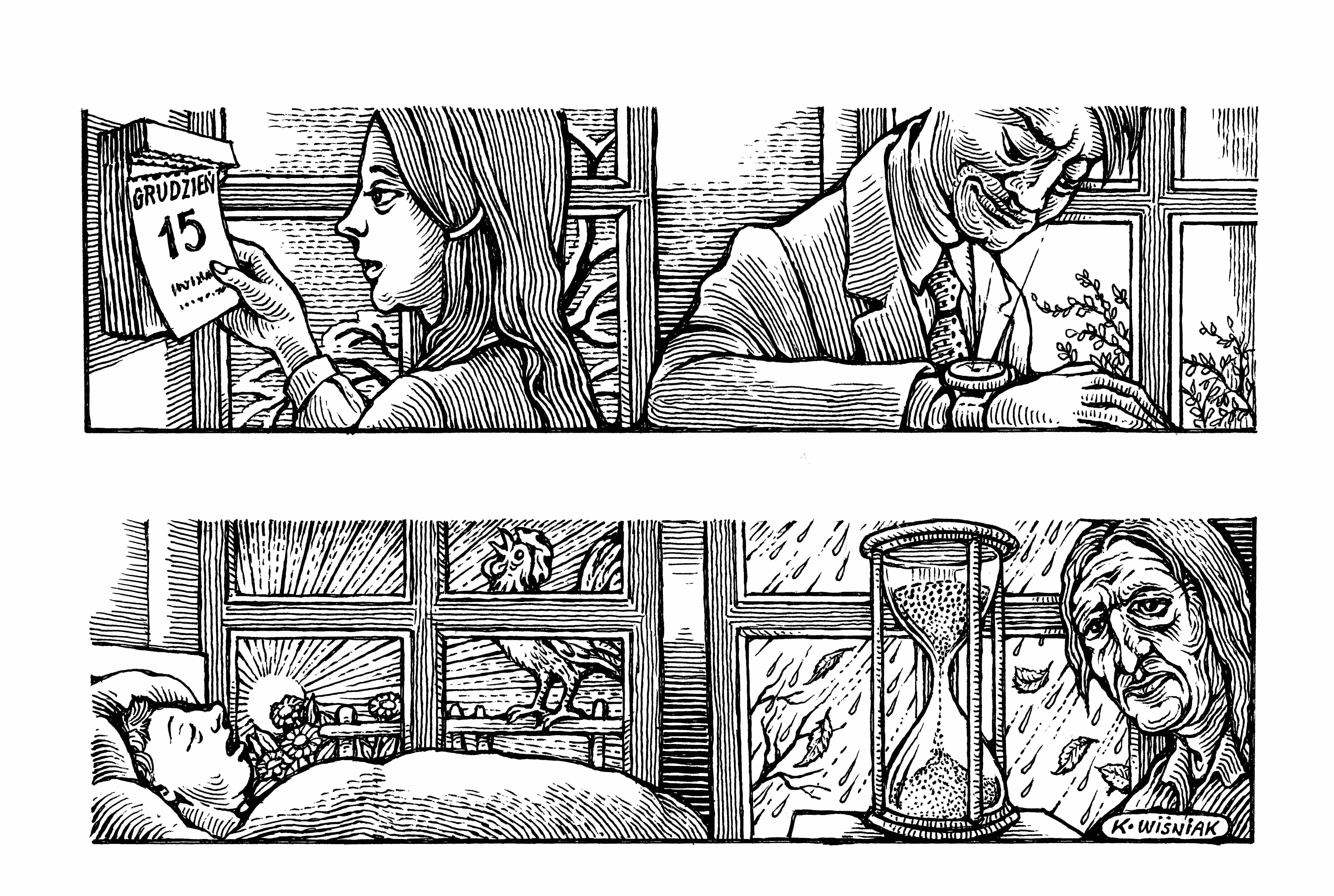
In your head, there’s this thing shaped like a cauliflower, with the texture of tofu. It generates the world you’re living in. Incredible, right? That’s why talking to Anil Seth, a professor of cognitive and computational neuroscience, is pretty amazing, as Maria Hawranek found out.
Maria Hawranek: In your book 30-Second Brain, you write that the brain is the shape of a cauliflower, has the texture of tofu, and has so many connections that it would take us about three million years to count them all. That’s beyond comprehension. Then you go on to describe how our perception is deceiving us. You mention inattentional blindness, phantom limbs, synaesthesia, and that colour basically doesn’t exist. So what does exist?
Anil Seth: The question about the relationship between what we perceive, the contents of our conscious experience and what actually exists, goes back as far as philosophy itself. I quite like Kant’s perspective on this. He said there is something out there, but we just don’t know what it is and we’ll never have direct access to it. But there’s obviously some relationship between what we perceive and reality. Otherwise, evolution wouldn’t have issued us with perceptual systems. On the other hand, perception isn’t necessarily geared towards maximum accuracy. Those perceptual systems are there to help us stay alive. They are shaped by what’s best for our survival – and that’s not the same thing as accuracy.
We’re very visual creatures, so let’s start with colour.
Ready when you are.
The vast majority of us experience a visual world that’s full of colour. But is colour a property of the external world? Well, no, not really. We know this from physics and from Newton. There are only electromagnetic light waves that are emitted, absorbed or refracted by objects. Our retinas are sensitive to a very, very small part of this electromagnetic spectrum – just three different wavelengths that we call red, green and blue. From those wavelengths, we generate our universe of colour. In a sense, we experience less than what’s really out there, because we’re only sensitive to this very thin slice of reality. But it’s also more than what’s out there, because we’re making an infinite number of colours from just three wavelengths. There’s no colour objectively in the world. There’s no colour in the brain. Colour is something the brain does. This point has been made by many people, especially artists. There’s a quote by Paul Klee, if I’m not mistaken, that colour is the place where the brain and the universe meet.
So the Impressionists were on the right track. They saw strange colours that seemingly aren’t there, but actually are.
Painters and other artists are investigating the same issues as neuroscientists – they’re trying to understand how perception works. They used to investigate perspective and how we perceive things in depth. Then the Impressionists came along and became interested in colour. In time, they reached a very astute understanding of how the visual system works. We can think about Impressionist paintings as a sort of reverse engineering of sight. They were trying to paint the light rather than what we see because of it.
We’re both wearing black, I think we agree on that. Intuition tells us that most of the time we are in agreement about the physical properties of what we see. How is that possible, if it’s all in our heads?
We can be overconfident about what we think we see. I’m reluctant to go too much into old philosophy, but there are important precedents. John Locke, the empiricist, distinguished between two different kinds of things: the first kind has properties that don’t depend on an observer – for example, solidity or velocity – and the second kind is completely shaped by our perception. I gave a TED talk once and I gave it the title Your brain hallucinates your conscious reality. A number of people emailed me to say: if you really think that, then go and stand in front of a bus and see what happens. Of course, it doesn’t matter whether the bus appears to me to be blue or red – it’s going to hurt when it hits me. It is still a solid object. As far as I know, there is a real world that exists – although Idealism says no, it’s all in the mind.
I’m of the opinion that the way we experience the world is always a construct. Some parts of it exist independently of the mind, but others like colour do not. You and I agree that we’re both wearing black at the moment. This is already a little bit complicated because on the one hand, it’s very likely we’re having very similar experiences because colour is a property of the way surfaces reflect light, and our visual systems have evolved and developed to pick up on these regularities. So it’s not surprising that we see things in a similar way. On the other hand, this is different from saying we have exactly the same experiences. It is almost impossible to know whether I am experiencing black, red or green the same way you are. We know some people are colour blind and they can’t distinguish between reds and greens. So what are they actually seeing when they see red? Then there are examples of cultural variation. Each culture divides the electromagnetic spectrum in its own way, but this spectrum is continuous, it doesn’t have the boundaries we arbitrarily establish. The Russian language has more words for shades of blue than the English language. There’s evidence that native Russian speakers perceive more shades of blue.
Some tribes in the Amazon distinguish dozens of shades of green.
Although in many ways we’re inhabiting similar perceptual worlds, our Umwelts – I’m using a beautiful German word employed by Jakob von Uexküll – aren’t identical. Sometimes we can dramatically overestimate how similar our perceptual worlds actually are. This was brought home in a beautiful example of found psychology. Remember the photograph of a dress from 2015 that half the world saw as blue and black and the other half saw as white and gold? Crucially, it wasn’t an experiment done in a lab, this wasn’t a hypothesis that a bunch of psychologists set out to test – it was serendipity. A bad photograph, overexposed and lacking in context, touched this previously unknown sweet spot and told us something important about differences in how people’s brains implement this thing called colour constancy.
If you take a white piece of paper outdoors, it still looks white, even though the light coming into your eye is changing. Why? Because our brains take account of the ambient lighting. In fact, that’s the point of perceiving colour: we need to keep track of objects and surfaces as lighting conditions change. If we were more accurate at perceiving the light coming into our eyes, this aim would be more difficult to achieve. Our eyes are not supposed to work like light meters. We need to follow the objects. The photograph that I mentioned had a particular property: it made it hard for a human brain to figure out what the ambient lighting was. Therefore, if your brain somehow assumed that it was taken indoors, you’d see it one way. If your brain assumed it was taken outdoors, you’d see different colours. At the same time, it was very hard to appreciate or even believe that other people’s perceptions weren’t the same as yours.
That’s amazing. I think we’re ready to dive deeper. Our brains decode, as best they can, the world outside us. But they also decode who we are. Do I understand correctly that the perception of ‘I’ is another construct?
We already know that colour is something the brain constructs. However, it’s related to something in the world in a regular and lawful way. How does the brain do it? Well, it’s this process of guessing. Instead of just collecting information from the world and decoding it, it always starts with a best guess and then updates those guesses based on sensory signals. It’s a top-down process, but a controlled one. Which is why I employ the term ‘controlled hallucination’. It doesn’t mean that everything we’re experiencing is made up. The word ‘controlled’ is just as important as the word ‘hallucination’. I’m talking about hallucination, because it’s generated internally. But it’s controlled by sensory signals. Hence there’s a kind of continuity between hallucination and perception. Hallucination in the everyday sense of the word is when perceptual best guesses become uncontrollable, when you start seeing things other people don’t see. Perception is a constant process of updating our best guesses. And here’s where it gets fascinating.
Go on.
What I’ve been describing concerns every way we perceive the world. It’s not just about individual sensory perceptions – vision, taste, touch or smell – but also about features of reality that don’t attach to any particular sense like, for instance, change. We experience change when our brain reaches the conclusion that this is the best interpretation of the sensory signals that it’s getting. Which means sometimes things can change and we don’t perceive it. On the other hand, sometimes we can perceive change when there’s no change going on. There’s plenty of visual optical illusions that illustrate these things really, really nicely. So that’s one part of the story: that all of the perceptual world is a construct.
And the second part?
The second part is that the ‘self’ is also a perception. We must abandon the idea that the ‘self’ is something that sits inside our heads, analysing the results of all this computation and then decides what to do or behaves in a particular way.
This doesn’t mean the ‘self’ isn’t real or that you and I don’t exist. Colours are real because we experience them. The ‘self’ exists because we experience it as existing. Also, the ‘self’ is not a single thing. There’s lots of philosophical and religious traditions that make this point. When I refer to my ‘self’, I’m referring to many things. For example, there’s the experience of a physical object that is my body – after all, I experience my own hand differently than, say, a mug I’m holding in it. Second, I experience moods and emotions not as properties of things in the world, but as something within myself. Next, I experience things like agency, intention and volition. For many people, this is at the core of what it means to be oneself. Then there are things like identity and memory. I experience myself as being a continuous person from hour to hour and day to day, and even to an extent from year to year. I associate this ‘self’ with a name, a set of memories and plans for the future. Then I experience myself in a social context: part of what it means to be ‘me’ is how I perceive others perceiving me because we, humans, are social animals. All of these things together collectively underpin the experience of being me. But they’re all inseparable.
How come?
There are plenty of examples from neurology and psychiatry that show how these different aspects of selfhood can come apart. There are people who completely lose their narrative self and continuity of personal identity over time because they have total amnesia. But they still experience their bodies, they still make volitional decisions and have emotions. They preserve some aspects of their selves, but not others. And, of course, you can have it the other way around, too. Look at people who completely lack the ability to make voluntary actions, but have perfectly good memory and sense of identity over time. So the challenge in understanding the ‘self’ is to consider all these different elements that collectively define being someone and to figure out how they all happen. I like to think of them all as varieties of perception. My brain is getting sensory signals from the body – about its posture, its kinetics, its movement – and then tries to make a best guess about what is and what is not part of the body. We know that this can be tricked. For example, there’s this famous rubber hand illusion where you can manipulate someone’s experience and body ownership in a subtle way.
What’s behind this experiment? It goes like this: you hide the real hand of a participant so that they can’t see it and put a rubber one in its place. Then you stroke both hands, the real and the fake one with a small brush. The brain makes a best guess and starts believing that the rubber hand is real. Then you suddenly jab the rubber hand with a knife, and people jump back, yes?
Yes. I spoke about it in my TED talk, but since then we’ve been doing a lot of work and the story I would tell about it now is very different. Now I think it’s an effective hypnotic suggestion. Hypnosis is one of those concepts from psychology that’s got a lot of generally unfortunate historical baggage. We think of it as some sort of trickery, weird and non-scientific. But that’s not really the case. After decades of work on hypnosis, we have very robust and reliable evidence that hypnosis simply refers to people’s suggestibility. If I suggest something’s crawling up your arm, you may feel it if you’re highly suggestible. Not everybody will react in this way. People differ quite a lot as far as suggestibility is concerned and it’s a very stable trait.
With the rubber hand illusion, you have two problems. First, the person looking at the fake hand is never 100% convinced it’s their real hand. So it’s different than the case of the dress we were talking about, where half the people were absolutely certain it’s blue and black, and the other half would swear it’s white and gold. With the rubber hand, what you’re getting is just a strange experience. Second, this experience varies from person to person. It turns out that a lot of this variability comes from how suggestible you are. If you think about it, the context of the rubber hand illusion is providing a very strong suggestion about what you ought to experience. Someone’s putting a fake hand in front of you, strokes it with a paintbrush and then asks you whether you experience it in a particular way. This is a very strong cue that you should have a particular kind of experience. Therefore, more suggestible people are more likely to have that experience.
What does it tell us?
For me, this just makes the story more interesting, because you can approach the suggestion as part of the process of coming to a best guess. Sensory data still matter, but now you’re adding those top-down expectations about what you should experience. And, of course, whether it’s suggestion or not, it’s still the case that you’re manipulating how people experience their body, which means that body ownership is quite changeable in people.
We can even completely lose it, for example, under general anaesthesia.
General anaesthesia is oblivion, erasure. You are gone, then you’re back and no time seems to have passed, unlike when you’re waking up from a nap. To me, it’s a sort of premonition of death, an insight into the nature of mortality that you can’t get in any other way. It does not matter to you that you’re not there – because you’re not there. Some people might find this very scary, but to me, it’s quite reassuring. Also, it really clearly makes the point that consciousness is dependent on the brain. The anaesthesiologist interferes with the brain. Your body is still alive, the heart still beats, you still have some brain activity, but you are gone. Consciousness is obliterated.
What happens to the brain?
Brain imaging of people under anaesthesia informs us that there are big changes in how different parts of the brain communicate with each other. There’s also a lot of complex changes in the network activity of the brain. But we still have a huge amount of questions to answer.
If the ‘self’ is a construct, how do we know that the person who wakes up is the same person who went to sleep?
Well, they are and aren’t. I’m not the same ‘myself’ I was yesterday – I’m slightly different. I’m different from when we started this conversation. However, it’s surprising how similar people are before and after completely ‘turning off’. When I had general anaesthesia, I woke up and I thought nothing had changed – until I saw the bandages.
What about the opposite thing: the out-of-body experience? Some people claim they live through their own death and then return. Sometimes they are even incorrectly pronounced dead. What happens to our consciousness then? If, as you say, consciousness stems from brain activity, such experiences shouldn’t be possible.
People make mistakes. The issue of deciding whether someone is dead or alive has been a very controversial thing. In the olden days, a person would be pronounced dead when they stopped breathing. But that’s not a reliable method, because people can come around after seemingly having not been breathing – for example, due to hypothermia. I’m sure you’ve heard about all these old cases of coffins equipped with a little cord attached to a bell so that a person could ring it in case they were accidentally buried alive. This was a very pragmatic solution. Then medicine went from breathing to the heartbeat and said: when the heart stops, you’re dead. But now, of course, we can sometimes bring people back after their heart stops. So currently it’s all about brain death. However, not everybody’s plugged into an EEG when they’re dying. There’s this very interesting and quite scary work that came out last year about reanimating pig’s brains. Researchers took the brains from recently slaughtered pigs, plugged them into a nutrient-pumping machine, and they restored some of the brains’ function. Those results have great clinical potential. When someone has a massive stroke, there’s not much time to get things going and limit the damage. The idea of being able to restore some function in a brain that has been deprived of oxygen for some time is exciting.
But, at the same time, we can’t be sure how to define the moment of death.
Yes, exactly. As technology improves, things are getting more difficult. Out-of-body experiences share some similarities with experiences of using psychedelic drugs. Depending on your prior beliefs, you can reach different conclusions about the significance of things like that. If you believe in a soul and you have an out-of-body experience, you’ll claim it is a point against materialism. But, of course, if you take my view, which is that the first-person perspective is just one of many – or, to put it differently, that it is merely one aspect of perception – then nothing’s changed. Also, the brain can be tricked. With virtual reality, you can put a camera on someone else, on a different body, and film your body from a different perspective. There are even more convincing demonstrations with brain stimulation. You can just gently activate parts of the human cortex and give rise to an on-demand out of body experience. This was done by Wilder Penfield in the 20th century and more recently by Olaf Blanke. If a gentle electrical tickle of some part of the brain can suddenly shift the perspective, then the experience of being outside the body cannot be treated as evidence that the soul is immaterial.
Does this mean that in the future we’ll be able to choose from what perspective we look at the world? People who meditate are apparently able to leave their bodies and then come back.
I think there’s clearly potential for generating those sorts of experiences. In a way, this is already happening. Take surgeons who guide operations remotely. Aren’t they having an out-of-body experience? After all, their first-person perspective is translated from where they are to where the operating theatre is. Also, there’s lots of interesting middle ground between the fully-fledged feeling of being totally dissociated from one body, and technologically induced states when you somehow feel somewhere else. Even Zoom is a little bit like this. We’re in two different places – I’m in Brighton, you’re in Kraków – but we don’t feel completely separated.
I once took part in an ayahuasca ritual in a church in Brazil. I was told that the brain does not distinguish between reality and experiences generated under the influence of a psychedelic substance, therefore regular use of it can be helpful in working through trauma. There’s a growing body of research suggesting that psychedelic substances can be of help in treating depression. Animals also react to it – octopuses, loners by nature, become more sociable under the influence of MDMA. What door of human consciousness do we open thanks to psychedelics?
That’s a huge topic. LSD, psilocybin and DMT – the substance in ayahuasca – activate serotonin receptor 2A. We’re talking about a very specific, pharmacological process due to which a small amount of substance radically changes the subjective perception of reality. Psychedelics are very useful for neuroscience because they allow us to alter conscious perception in a controlled, reversible fashion. Therefore we can learn a lot about experiencing the ‘self’. Robin Carhart-Harris (co-author of my book about the human brain) and David Nutt conducted a pioneering study on psychedelics. Those substances shift the balance in perception between hallucination and control – or, if you like, they make perception a little less of a controlled hallucination. Even in normal life, without psychedelics, you sometimes look at clouds and see faces there. That’s because the brain has some very strong expectations – faces are important for us as a species. Psychedelics are ramping up that process, so you see patterns in things much more easily and vividly than you would otherwise.
As in your experiment with dogs coming out of every corner? That sounds quite scary.
We used an algorithm called Google Deep Dream to simulate what a psychedelic experience might be like. We took a video and every frame was processed with the expectation that somewhere out there is a dog. Because it was a panoramic video, allowing you to look around in 360 degrees, you would see dogs organically coming out of all parts of your world. It’s certainly not exactly like a psychedelic hallucination, but it’s kind of similar. This sort of research gives us insight into what might be happening in the brain, in the cortical circuits that underlie perception.
So psychedelics are useful for researchers and can improve certain therapies.
After using psychedelics, people often report a sense of being alive, of everything being more precious, but also a sense of ego dissolution. They perceive themselves as more continuous with the world around them. You can definitely see how that could be very beneficial in psychotherapy. A lot of mental health conditions like depression involve people perceiving the world and themselves in a particular way. Things are bad, things will always be bad, I’m bad. Psychedelics can kick you out of that state, at least temporarily. They open the possibility of seeing things differently. Of course, it’s not a magic bullet. I think there’s a lot of boosterism about psychedelics, kind of Yeah, give it to anyone and it’s gonna be fine. That’s not the case, but I do think there’s a lot of potential.
They can also increase our sensitivity.
It’s a difficult hypothesis to test because, again, the experiences are going to be so variable, depending on the substance and on the person who uses it, their previous experiences, mood, context. I think it’s a little bit like the dress we were talking about. Psychedelic experiences, if you interpret them in a particular way, make it very clear to you that your perception is a construction, that it’s somewhat arbitrary and changeable. This has a lot of implications for our society, because we’re already getting used to the idea that we experience reality in quite different ways – not only because of echo chambers and filter bubbles, or because we only read particular newspapers and only believe certain things about the world. If a person understands that they sometimes see the same thing differently, that their perception is not fixed, that they don’t experience reality directly, it may open a little bit of space where we can all appreciate that other people might literally see things differently from us. Perhaps in the future, this will help us understand ourselves and our conflicts.
Do all scientists share your view on controlled hallucination?
You can always find someone who’s going to disagree. And I can’t claim authorship – this idea has been circling in the scientific world for a long time. I think pretty much everyone would agree that the way we perceive the world is not identical to the way the world actually is; that we’re not only filtering it, but also constructing it. However, people have different theories about the process by which this is happening.
Joseph LeDoux, a distinguished American neurobiologist, shares your view, but you two seem to disagree on who you ascribe consciousness to. According to him, since we cannot know anything about the experiences of animals and babies – because we can’t ask them anything – it’s impossible to say whether they’re conscious beings or not. You, however, extend consciousness to them.
Joseph is a wonderful scientist and he’s been an inspiration for me over the years. We agree on a lot of things and we both emphasize that the living body is important for consciousness and the ‘self’. I know am Anil Seth, that it’s Thursday morning, that I’m thinking about my plans for the day. That’s a sort of high-level self-awareness. I’m not only aware of myself, but I’m also aware that I am aware. This layer can be stripped away and consciousness remains. I think that’s what’s happening with infants and many animals. They experience the world, their own bodies, agency and emotion, all these sorts of things, but don’t necessarily know that they are the subjects of those experiences in this high-level way.
We started this conversation by talking about how we perceive things. Then we went deeper. But now it’s time to turn the other way and ask the question, why do we perceive things in the first place? Where did those mechanisms of perception come from? Why did they evolve?
Why did they?
To control a living body. I don’t see my internal organs and when I experience pain I don’t always know where it is located. However, what these experiences tell me is how well I’m doing and staying alive, they inform me about my current and future prospects of survival. It turns out that a good way to regulate a system, whether it’s a body or a central heating system or a guided missile, is to have a prediction about the causes of sensory signals. With our perception of the external world, it’s exactly the same. Ultimately, we’re perceiving the world because it matters for our survival.
Personally, I’d like to believe that babies and animals are conscious.
Let’s go back to philosophy. Descartes famously described non-human animals as bête-machines or ‘beast machines’, denying them the rational mind that distinguishes humans. To him, they were things made out of flesh and blood, but not in possession of res cogitans – the mind. So, according to Descartes, being alive was separable from consciousness. Well, I disagree. I’d point to another philosopher, Julien Offray de La Mettrie, who actually got himself in trouble with the Church because he would say: well, if animals and humans are made of the same flesh and blood, maybe we are kind of machines, too. Or maybe animals have souls. I think we are conscious because we are living bodies. That does not mean that every living creature is conscious, nor does it mean that being alive is a strict prerequisite for having consciousness. However, in order to understand what consciousness is for us humans and for other animals, we need to appreciate its roots in the physiology of life.
You’ve mentioned conscious machines – but you don’t suppose AI might, one day, reach consciousness, right?
Artificial intelligence is already changing the world, so there’s lots of ethical issues that need to be urgently addressed. Some people claim intelligence is related to consciousness, so when an AI reaches a certain threshold, it will become conscious. You see this trope in lots of science fiction films, but I don’t believe it. Intelligence and consciousness come together in humans, and this tendency to put them together is just another manifestation of one of the most problematic biases in human thinking: we see ourselves as central to everything and we project our own traits, judgements and experiences onto other things. I think it’s perfectly possible to be sentient, aware and conscious without being smart. Conversely, there’s no reason to think that intelligence necessarily entails consciousness. My intuition is that it matters what a thing is made out of. But maybe it doesn’t, maybe a silicon-based machine could become conscious. I just don’t know, so we need to worry about it a little bit, because in theory, we could accidentally create consciousness.
How?
Have you heard about brain organoids? This is a new technology where people are growing brain-like structures in the lab from human stem cells. They are clinically very useful, in particular as models of neurodegenerative and neurodevelopmental diseases. Are they conscious? Seems unlikely. They’re not brains, they have no input or output. But given that there isn’t a consensus about the minimal sufficient conditions for consciousness, we should be a bit worried. I’m more concerned about organoids than about AI, because they are made of the same stuff as we are, of the same kind of neurons that make up your brain and mine.
It’s easy to get lost in all of this. If our perceptions aren’t necessarily accurate, if the way we look at ourselves may be a perception error, how do we trust our judgements about ourselves and the world? Should we be constantly questioning what we think and feel? You said that the human brain has evolved to be helpful, but during our conversation, I realized how fallible it is. Maybe we should limit our trust in it? On the other hand, if I’m constantly questioning myself, I won’t be able to do anything. So should I trust myself or not?
It’s a very good question. The challenge is to nurture both perspectives at once. Our perceptual systems have evolved to be useful. If every colour seemed unreal or if I didn’t perceive it as constant, it would be quite bothersome. Fortunately, I still see this mug as yellow. The knowledge that it’s just the brain’s construct doesn’t change that. I still see myself as Anil Seth, I wasn’t hit by any deep existential crisis. At the same time, I know that this experience of ‘self’ is a bit shakily constructed. This knowledge can be useful. I think a lot of suffering and many problems come from a too rigidly held idea that the ‘self’ is unchanging, permanent. Here, we come to one of the most beautiful traditions of human thought, which is present in meditation, in Buddhism and in all sorts of religions, actually – those traditions that keep their focus on impermanence, on changes. Recognizing that can be very liberating.
Parts of this interview have been edited and condensed for clarity and brevity.

Anil Seth:
Born in 1972. Professor of Cognitive and Computational Neuroscience at the University of Sussex. His research is focused on the foundations of human perception. He is a co-author of 30-Second Brain. In 2020, he published Being You: A New Science of Consciousness.
Introduction and biography translated from the Polish by Jan Dziergowski









